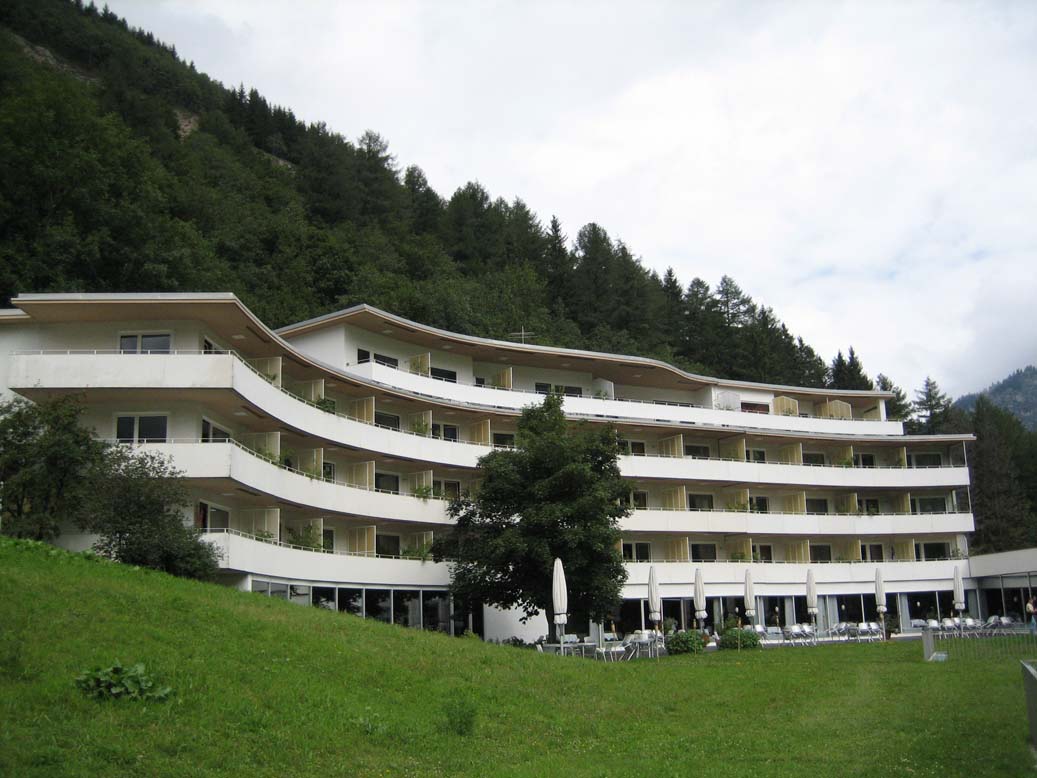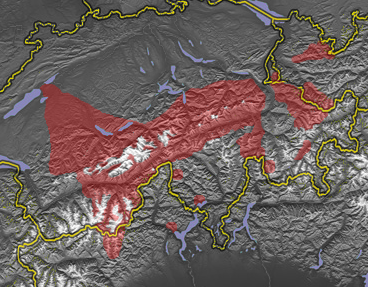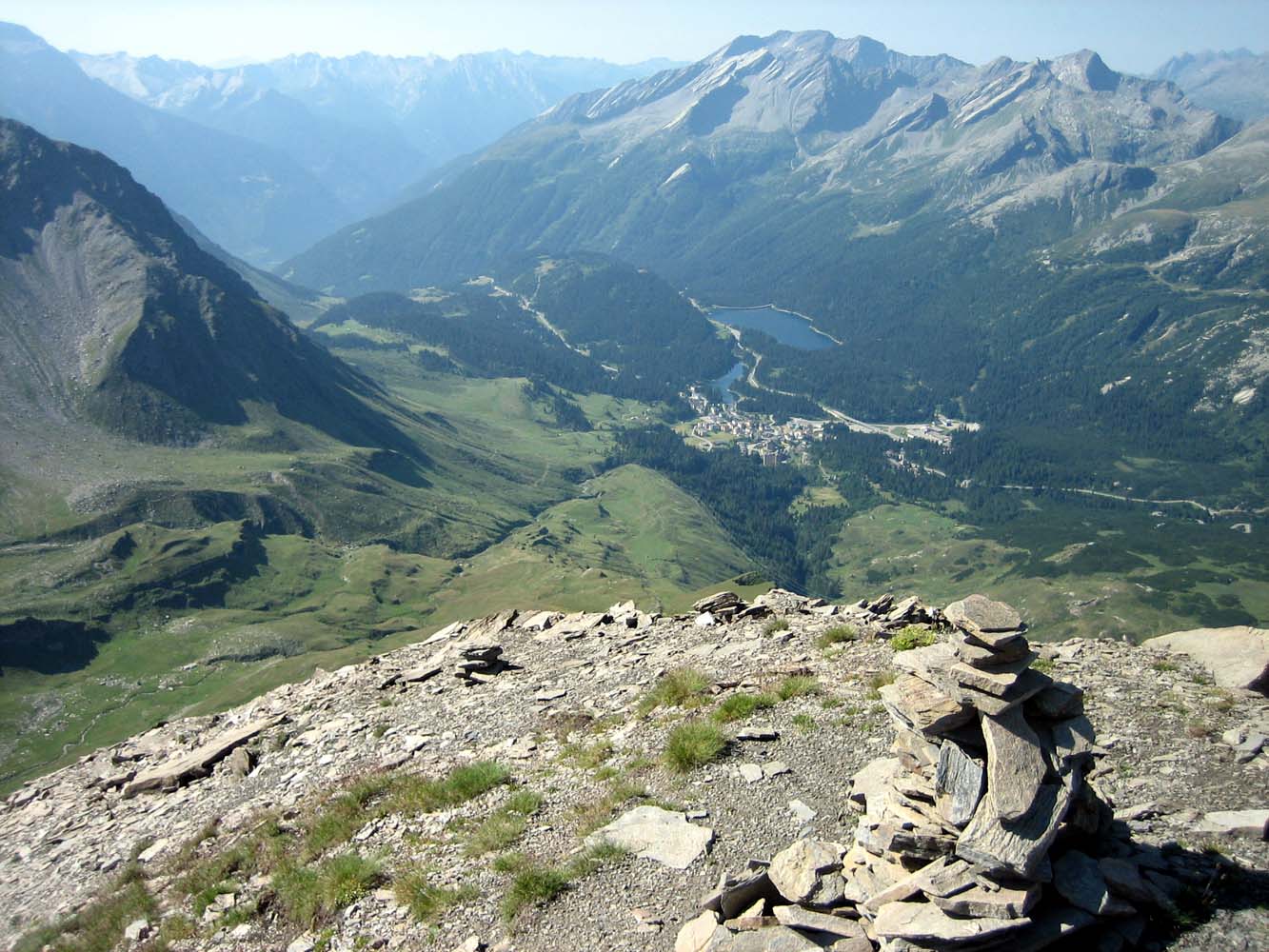|
Vals Valley
The Vals Valley (german: Valser Tal) is located in the canton of Graubünden in Switzerland. Geography The Vals Valley is a roughly 16 kilometers long valley. At Uors, it branches off to the south from the Lumnezia. The valley is drained by the Valser Rhine. There are two municipalities in the valley: Vals and St. Martin. The population is spread out across several hamlets and the village of , which has an altitude of 1250 m. They form a Walser enclave, since the people in the adjacent Lumnezia speak Romansh. History Isolated finds show that the Vals Valley was used as a link between the Mesolcina and the Alpine Rhine Valley as early as the Bronze Age. The lower part of the valley was settled in the 12th Century, if not earlier. Low justice was provided by the court in Sagogn; high justice by the barons of Belmont. In the 14th century, the upper part of the valley was settled by the Walser migration. Tourism Therme Vals, the only hot spring in Graubünden where hot wat ... [...More Info...] [...Related Items...] OR: [Wikipedia] [Google] [Baidu] |
Alpine Rhine Valley
The Alpine Rhine Valley (german: Alpenrheintal) is a glacial alpine valley, formed by the part of the Alpine Rhine (german: Alpenrhein ) between the confluence of the Anterior Rhine and Posterior Rhine at Reichenau and the Alpine Rhine's mouth at Lake Constance. It covers three countries and the full length of the Alpine Rhine is 93.5 km. From Reichenau, the Alpine Rhine flows east, passing Chur and turning north, before it turns north-east at Landquart, and then roughly north, east of Sargans. From here, the Alpine Rhine forms the border between the canton of St. Gallen of Switzerland on the left, west side, and the Principality of Liechtenstein on the east side. About further down, the Rhine then meets the Austrian federal state Vorarlberg and finally flows into Lake Constance, south of Lindau (Germany), which is no longer part of the Rhine Valley. The Swiss-Austrian border follows the historical bed of the Rhine, but today the river follows an artificial canal within Aus ... [...More Info...] [...Related Items...] OR: [Wikipedia] [Google] [Baidu] |
Hot Spring
A hot spring, hydrothermal spring, or geothermal spring is a spring produced by the emergence of geothermally heated groundwater onto the surface of the Earth. The groundwater is heated either by shallow bodies of magma (molten rock) or by circulation through faults to hot rock deep in the Earth's crust. In either case, the ultimate source of the heat is radioactive decay of naturally occurring radioactive elements in the Earth's mantle, the layer beneath the crust. Hot spring water often contains large amounts of dissolved minerals. The chemistry of hot springs ranges from acid sulfate springs with a pH as low as 0.8, to alkaline chloride springs saturated with silica, to bicarbonate springs saturated with carbon dioxide and carbonate minerals. Some springs also contain abundant dissolved iron. The minerals brought to the surface in hot springs often feed communities of extremophiles, microorganisms adapted to extreme conditions, and it is possible that life on Earth had its ... [...More Info...] [...Related Items...] OR: [Wikipedia] [Google] [Baidu] |
Therme Vals
7132 Thermal Baths (formerly Therme Vals) is a hotel/spa complex in Vals, built over the only thermal springs in the Graubünden canton in Switzerland. Completed in 1996, the spa was designed by Peter Zumthor (Pritzker 2009). History In the 1960s a German property developer, Karl Kurt Vorlop, built a hotel complex with over 1,000 beds to take advantage of the naturally occurring thermal springs and the source, which provides the water for Valser mineral water, sold in Switzerland. After the developer went bankrupt, the village of Vals bought the five hotels in development in 1983 and commissioned a hydrotherapy centre at the middle of the five hotels on the source of the thermal springs. The spa facility was built between 1993 and 1996, designed by Peter Zumthor. In 2012, the hotel and spa, previously owned by the Vals community, was sold to the investor Remo Stoffel for CHF 7.8 million. Stoffel renamed the thermal site 7132 Therme & Hotel. Stoffel turned the spa into a lu ... [...More Info...] [...Related Items...] OR: [Wikipedia] [Google] [Baidu] |
Walser
The Walser people are the speakers of the Walser German dialects, a variety of Highest Alemannic. They inhabit the region of the Alps of Switzerland and Liechtenstein, as well as the fringes of Italy and Austria. The Walser people are named after the Wallis (Valais), the uppermost Rhône valley, where they settled from roughly the 10th century in the late phase of the migration of the Alamanni, crossing from the Bernese Oberland; because of linguistic differences among the Walser dialects, it is supposed that there were two independent immigration routes. From the upper Wallis, they began to spread south, west and east between the 12th and 13th centuries, in the so-called Walser migrations (''Walserwanderungen''). The causes of these further population movements, the last wave of settlement in the higher valleys of the Alps, are not entirely clear. Some think that the large ''Walser'' migrations took place because of conflicts with the valley's feudal lords. Other theories con ... [...More Info...] [...Related Items...] OR: [Wikipedia] [Google] [Baidu] |
Sagogn
Sagogn (; german: Sagens) is a municipality in the Surselva Region in the canton of Graubünden in Switzerland. History Sagogn is first mentioned in 765 as ''Secanio''. Geography Sagogn has an area, , of . Of this area, 23.2% is used for agricultural purposes, while 59.7% is forested. Of the rest of the land, 4.7% is settled (buildings or roads) and the remainder (12.4%) is non-productive (rivers, glaciers or mountains). Before 2017, the municipality was located in the Ilanz sub-district of the Surselva district, after 2017 it was part of the Surselva Region. It is on the northern slope above the Vorderrhein on the bank of the Gruob (or Foppa). It consists of the village sections of Innerdorf (Vitg Dadens) and Ausserdorf (Vitg Dado). Until 1943 Sagogn was known by its German name as Sagens. [...More Info...] [...Related Items...] OR: [Wikipedia] [Google] [Baidu] |
Low Justice
High, middle and low justices are notions dating from Western feudalism to indicate descending degrees of judicial power to administer justice by the maximal punishment the holders could inflict upon their subjects and other dependents. Low justice regards the level of day-to-day civil actions, including voluntary justice, minor pleas, and petty offences generally settled by fines or light corporal punishment. It was held by many lesser authorities, including many lords of the manor, who sat in justice over the serfs, unfree tenants, and freeholders on their land. Middle justice would involve full civil and criminal jurisdiction, except for capital crimes, and notably excluding the right to pass the death penalty, torture and severe corporal punishment, which was reserved to authorities holding high justice, or the ''ius gladii'' ("right of the sword"). Pyramid of feudal justice Although the terms ''high'' and ''low'' suggest a strict subordination, this was not quite the case ... [...More Info...] [...Related Items...] OR: [Wikipedia] [Google] [Baidu] |
Bronze Age
The Bronze Age is a historic period, lasting approximately from 3300 BC to 1200 BC, characterized by the use of bronze, the presence of writing in some areas, and other early features of urban civilization. The Bronze Age is the second principal period of the three-age system proposed in 1836 by Christian Jürgensen Thomsen for classifying and studying ancient societies and history. An ancient civilization is deemed to be part of the Bronze Age because it either produced bronze by smelting its own copper and alloying it with tin, arsenic, or other metals, or traded other items for bronze from production areas elsewhere. Bronze is harder and more durable than the other metals available at the time, allowing Bronze Age civilizations to gain a technological advantage. While terrestrial iron is naturally abundant, the higher temperature required for smelting, , in addition to the greater difficulty of working with the metal, placed it out of reach of common use until the end o ... [...More Info...] [...Related Items...] OR: [Wikipedia] [Google] [Baidu] |
Mesolcina
The ''Valle Mesolcina'', also known as the ''Val Mesolcina'' or ''Misox'' (German), is an alpine valley of the Grisons, Switzerland, stretching from the San Bernardino Pass to Grono where it joins the Calanca Valley. It is the valley formed by the river Moesa. Like the Val Bregaglia or the Val Poschiavo, the Valle Mesolcina is a valley lying south of the main ridge of the Alps. Although politically the Valle Mesolcina belongs to the Grisons, its population is predominantly Italian-speaking and culturally oriented towards the Ticino. The valley includes the Mesocco and Roveredo of the Moesa district, including: * Mesocco * Soazza * Lostallo * Verdabbio * Cama * Leggia * Grono * Roveredo Roveredo is a municipality in the Moesa Region in the canton of Graubünden in Switzerland. Geography Roveredo has an area, , of . Of this area, 8.6% is used for agricultural purposes, while 75% is forested. Of the rest of the land, 3.1% is ... * San Vittore External links * ... [...More Info...] [...Related Items...] OR: [Wikipedia] [Google] [Baidu] |
Switzerland
). Swiss law does not designate a ''capital'' as such, but the federal parliament and government are installed in Bern, while other federal institutions, such as the federal courts, are in other cities (Bellinzona, Lausanne, Luzern, Neuchâtel, St. Gallen a.o.). , coordinates = , largest_city = Zürich , official_languages = , englishmotto = "One for all, all for one" , religion_year = 2020 , religion_ref = , religion = , demonym = , german: Schweizer/Schweizerin, french: Suisse/Suissesse, it, svizzero/svizzera or , rm, Svizzer/Svizra , government_type = Federalism, Federal assembly-independent Directorial system, directorial republic with elements of a direct democracy , leader_title1 = Federal Council (Switzerland), Federal Council , leader_name1 = , leader_title2 = , leader_name2 = Walter Thurnherr , legislature = Fe ... [...More Info...] [...Related Items...] OR: [Wikipedia] [Google] [Baidu] |
Romansh Language
Romansh (; sometimes also spelled Romansch and Rumantsch; Sursilvan: ; Vallader, Surmiran, and Rumantsch Grischun: ; Putèr: ; Sutsilvan: , , ; Jauer: ) is a Gallo-Romance language spoken predominantly in the Swiss canton of the Grisons (Graubünden). Romansh has been recognized as a national language of Switzerland since 1938, and as an official language in correspondence with Romansh-speaking citizens since 1996, along with German, French, and Italian. It also has official status in the canton of the Grisons alongside German and Italian and is used as the medium of instruction in schools in Romansh-speaking areas. It is sometimes grouped by linguists with Ladin and Friulian as the Rhaeto-Romance languages, though this is disputed. Romansh is one of the descendant languages of the spoken Latin language of the Roman Empire, which by the 5th century AD replaced the Celtic and Raetic languages previously spoken in the area. Romansh retains a small number of words fro ... [...More Info...] [...Related Items...] OR: [Wikipedia] [Google] [Baidu] |
Walser German
Walser German (german: Walserdeutsch) and Walliser German (, locally ) are a group of Highest Alemannic dialects spoken in parts of Switzerland (Valais, Ticino, Grisons), Italy (Piedmont, Aosta Valley), Liechtenstein (Triesenberg, Planken), and Austria (Vorarlberg). Usage of the terms Walser and Walliser has come to reflect a difference of geography, rather than language. The term ''Walser'' refers to those speakers whose ancestors migrated into other Alpine valleys in medieval times, whereas ''Walliser'' refers only to a speaker from Upper Valais – that is, the upper Rhone valley. In a series of migrations during the Late Middle Ages, people migrated out of the Upper Valais, across the higher valleys of the Alps. History The Alemannic immigration to the Rhone valley started in the 8th century. There were presumably two different immigration routes, from what is now the Bernese Oberland, that led to two main groups of Walliser dialects. In the 12th or 13th century, the ... [...More Info...] [...Related Items...] OR: [Wikipedia] [Google] [Baidu] |


.jpg)





